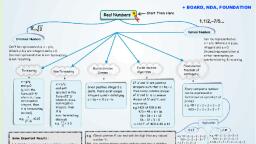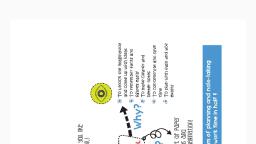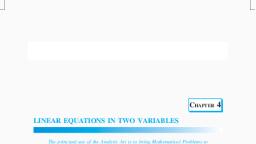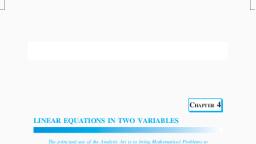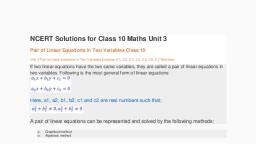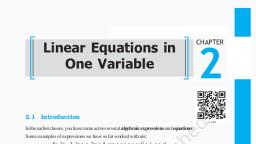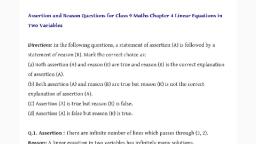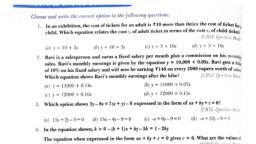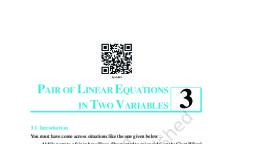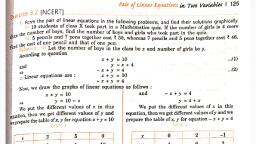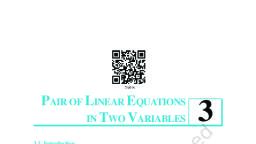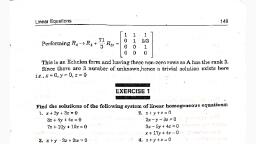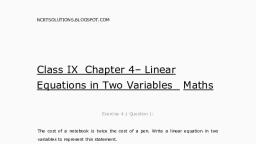Page 1 :
66, , MATHEMATICS, , CHAPTER 4, LINEAR EQUATIONS IN TWO VARIABLES, The principal use of the Analytic Art is to bring Mathematical Problems to, Equations and to exhibit those Equations in the most simple terms that can be., —Edmund Halley, , 4.1 Introduction, In earlier classes, you have studied linear equations in one variable. Can you write, down a linear equation in one variable? You may say that x + 1 = 0, x + 2 = 0 and, 2 y + 3 = 0 are examples of linear equations in one variable. You also know that, such equations have a unique (i.e., one and only one) solution. You may also remember, how to represent the solution on a number line. In this chapter, the knowledge of linear, equations in one variable shall be recalled and extended to that of two variables. You, will be considering questions like: Does a linear equation in two variables have a, solution? If yes, is it unique? What does the solution look like on the Cartesian plane?, You shall also use the concepts you studied in Chapter 3 to answer these questions., , 4.2 Linear Equations, Let us first recall what you have studied so far. Consider the following equation:, 2x + 5 = 0, , 5, Its solution, i.e., the root of the equation, is − . This can be represented on the, 2, number line as shown below:, , Fig. 4.1, 2021–22
Page 2 :
LINEAR EQUATIONS IN TWO VARIABLES, , 67, , While solving an equation, you must always keep the following points in mind:, The solution of a linear equation is not affected when:, (i) the same number is added to (or subtracted from) both the sides of the equation., (ii) you multiply or divide both the sides of the equation by the same non-zero, number., Let us now consider the following situation:, In a One-day International Cricket match between India and Sri Lanka played in, Nagpur, two Indian batsmen together scored 176 runs. Express this information in the, form of an equation., Here, you can see that the score of neither of them is known, i.e., there are two, unknown quantities. Let us use x and y to denote them. So, the number of runs scored, by one of the batsmen is x, and the number of runs scored by the other is y. We know, that, x + y = 176,, which is the required equation., This is an example of a linear equation in two variables. It is customary to denote, the variables in such equations by x and y, but other letters may also be used. Some, examples of linear equations in two variables are:, 1.2s + 3t = 5, p + 4q = 7, πu + 5v = 9 and 3 =, , 2 x – 7y., , Note that you can put these equations in the form 1.2s + 3t – 5 = 0,, p + 4q – 7 = 0, πu + 5v – 9 = 0 and 2 x – 7y – 3 = 0, respectively., So, any equation which can be put in the form ax + by + c = 0, where a, b and c, are real numbers, and a and b are not both zero, is called a linear equation in two, variables. This means that you can think of many many such equations., Example 1 : Write each of the following equations in the form ax + by + c = 0 and, indicate the values of a, b and c in each case:, (i) 2x + 3y = 4.37, , (ii) x – 4 =, , 3y, , (iii) 4 = 5x – 3y, , (iv) 2x = y, , Solution : (i) 2x + 3y = 4.37 can be written as 2x + 3y – 4.37 = 0. Here a = 2, b = 3, and c = – 4.37., (ii) The equation x – 4 =, b = – 3 and c = – 4., , 3 y can be written as x –, , 3 y – 4 = 0. Here a = 1,, , (iii) The equation 4 = 5x – 3y can be written as 5x – 3y – 4 = 0. Here a = 5, b = –3, and c = – 4. Do you agree that it can also be written as –5x + 3y + 4 = 0 ? In this, case a = –5, b = 3 and c = 4., , 2021–22
Page 3 :
68, , MATHEMATICS, , (iv) The equation 2x = y can be written as 2x – y + 0 = 0. Here a = 2, b = –1 and, c = 0., Equations of the type ax + b = 0 are also examples of linear equations in two variables, because they can be expressed as, ax + 0.y + b = 0, For example, 4 – 3x = 0 can be written as –3x + 0.y + 4 = 0., Example 2 : Write each of the following as an equation in two variables:, (i) x = –5, , (ii) y = 2, , (iii) 2x = 3, , (iv) 5y = 2, , Solution : (i) x = –5 can be written as 1.x + 0.y = –5, or 1.x + 0.y + 5 = 0., (ii) y = 2 can be written as 0.x + 1.y = 2, or 0.x + 1.y – 2 = 0., (iii) 2x = 3 can be written as 2x + 0.y – 3 = 0., (iv) 5y = 2 can be written as 0.x + 5y – 2 = 0., , EXERCISE 4.1, 1., , The cost of a notebook is twice the cost of a pen. Write a linear equation in two, variables to represent this statement., (Take the cost of a notebook to be ` x and that of a pen to be ` y)., , 2., , Express the following linear equations in the form ax + by + c = 0 and indicate the, values of a, b and c in each case:, y, (i) 2x + 3y = 9.35 (ii) x –, – 10 = 0, (iii) –2x + 3y = 6, (iv) x = 3y, 5, (v) 2x = –5y, (vi) 3x + 2 = 0, (vii) y – 2 = 0, (viii) 5 = 2x, , 4.3 Solution of a Linear Equation, You have seen that every linear equation in one variable has a unique solution. What, can you say about the solution of a linear equation involving two variables? As there, are two variables in the equation, a solution means a pair of values, one for x and one, for y which satisfy the given equation. Let us consider the equation 2x + 3y = 12., Here, x = 3 and y = 2 is a solution because when you substitute x = 3 and y = 2 in the, equation above, you find that, 2x + 3y = (2 × 3) + (3 × 2) = 12, This solution is written as an ordered pair (3, 2), first writing the value for x and, then the value for y. Similarly, (0, 4) is also a solution for the equation above., , 2021–22
Page 4 :
LINEAR EQUATIONS IN TWO VARIABLES, , 69, , On the other hand, (1, 4) is not a solution of 2x + 3y = 12, because on putting, x = 1 and y = 4 we get 2x + 3y = 14, which is not 12. Note that (0, 4) is a solution but, not (4, 0)., You have seen at least two solutions for 2x + 3y = 12, i.e., (3, 2) and (0, 4). Can, you find any other solution? Do you agree that (6, 0) is another solution? Verify the, same. In fact, we can get many many solutions in the following way. Pick a value of, your choice for x (say x = 2) in 2x + 3y = 12. Then the equation reduces to 4 + 3y = 12,, , 8, 8, . So 2, is, 3, 3, another solution of 2x + 3y = 12. Similarly, choosing x = – 5, you find that the equation, which is a linear equation in one variable. On solving this, you get y =, , 22, 22 , . So, −5,, is another solution of, 3, 3 , , 2x + 3y = 12. So there is no end to different solutions of a linear equation in two, variables. That is, a linear equation in two variables has infinitely many solutions., becomes –10 + 3y = 12. This gives y =, , Example 3 : Find four different solutions of the equation x + 2y = 6., Solution : By inspection, x = 2, y = 2 is a solution because for x = 2, y = 2, x + 2y = 2 + 4 = 6, Now, let us choose x = 0. With this value of x, the given equation reduces to 2y = 6, which has the unique solution y = 3. So x = 0, y = 3 is also a solution of x + 2y = 6., Similarly, taking y = 0, the given equation reduces to x = 6. So, x = 6, y = 0 is a solution, of x + 2y = 6 as well. Finally, let us take y = 1. The given equation now reduces to, x + 2 = 6, whose solution is given by x = 4. Therefore, (4, 1) is also a solution of the, given equation. So four of the infinitely many solutions of the given equation are:, (2, 2), (0, 3), (6, 0) and (4, 1)., Remark : Note that an easy way of getting a solution is to take x = 0 and get the, corresponding value of y. Similarly, we can put y = 0 and obtain the corresponding, value of x., Example 4 : Find two solutions for each of the following equations:, (i) 4x + 3y = 12, (ii) 2x + 5y = 0, (iii) 3y + 4 = 0, Solution : (i) Taking x = 0, we get 3y = 12, i.e., y = 4. So, (0, 4) is a solution of the, given equation. Similarly, by taking y = 0, we get x = 3. Thus, (3, 0) is also a solution., (ii) Taking x = 0, we get 5y = 0, i.e., y = 0. So (0, 0) is a solution of the given equation., , 2021–22
Page 5 :
70, , MATHEMATICS, , Now, if you take y = 0, you again get (0, 0) as a solution, which is the same as the, earlier one. To get another solution, take x = 1, say. Then you can check that the, , 2, 2, , corresponding value of y is − . So 1, − is another solution of 2x + 5y = 0., 5, 5, , (iii) Writing the equation 3y + 4 = 0 as 0.x + 3y + 4 = 0, you will find that y = –, , , any value of x. Thus, two solutions can be given as 0, –, , , 4, 4, , and 1, – ., 3, 3, , , 4, for, 3, , EXERCISE 4.2, 1., , Which one of the following options is true, and why?, y = 3x + 5 has, (i) a unique solution,, , 2., , (ii) πx + y = 9, , (iii) x = 4y, , Check which of the following are solutions of the equation x – 2y = 4 and which are, not:, (i) (0, 2), (ii) (2, 0), (iii) (4, 0), (iv), , 4., , (iii) infinitely many solutions, , Write four solutions for each of the following equations:, (i) 2x + y = 7, , 3., , (ii) only two solutions,, , (, , 2, 4 2, , ), , (v) (1, 1), , Find the value of k, if x = 2, y = 1 is a solution of the equation 2x + 3y = k., , 4.4 Graph of a Linear Equation in Two Variables, So far, you have obtained the solutions of a linear equation in two variables algebraically., Now, let us look at their geometric representation. You know that each such equation, has infinitely many solutions. How can we show them in the coordinate plane? You, may have got some indication in which we write the solution as pairs of values. The, solutions of the linear equation in Example 3, namely,, x + 2y = 6, (1), can be expressed in the form of a table as follows by writing the values of y below the, corresponding values of x :, Table 1, x, , 0, , 2, , 4, , 6, , ..., , y, , 3, , 2, , 1, , 0, , ..., , 2021–22
Page 6 :
LINEAR EQUATIONS IN TWO VARIABLES, , 71, , In the previous chapter, you, studied how to plot the points on a, graph paper. Let us plot the points, (0, 3), (2, 2), (4, 1) and (6, 0) on a, graph paper. Now join any two of, these points and obtain a line. Let us, call this as line AB (see Fig. 4.2)., Do you see that the other two, points also lie on the line AB? Now,, pick another point on this line, say, (8, –1). Is this a solution? In fact,, 8 + 2(–1) = 6. So, (8, –1) is a solution., Pick any other point on this line AB, and verify whether its coordinates, Fig. 4.2, satisfy the equation or not. Now, take, any point not lying on the line AB, say (2, 0). Do its coordinates satisfy the equation?, Check, and see that they do not., Let us list our observations:, 1. Every point whose coordinates satisfy Equation (1) lies on the line AB., 2. Every point (a, b) on the line AB gives a solution x = a, y = b of Equation (1)., 3. Any point, which does not lie on the line AB, is not a solution of Equation (1)., So, you can conclude that every point on the line satisfies the equation of the line, and every solution of the equation is a point on the line. In fact, a linear equation in two, variables is represented geometrically by a line whose points make up the collection of, solutions of the equation. This is called the graph of the linear equation. So, to obtain, the graph of a linear equation in two variables, it is enough to plot two points, corresponding to two solutions and join them by a line. However, it is advisable to plot, more than two such points so that you can immediately check the correctness of the, graph., Remark : The reason that a, degree one, polynomial equation ax + by + c = 0 is called, a linear equation is that its geometrical representation is a straight line., Example 5 : Given the point (1, 2), find the equation of a line on which it lies. How, many such equations are there?, Solution : Here (1, 2) is a solution of a linear equation you are looking for. So, you are, looking for any line passing through the point (1, 2). One example of such a linear, equation is x + y = 3. Others are y – x = 1, y = 2x, since they are also satisfied by the, coordinates of the point (1, 2). In fact, there are infinitely many linear equations which, , 2021–22
Page 7 :
72, , MATHEMATICS, , are satisfied by the coordinates of the point (1, 2). Can you see this pictorially?, Example 6 : Draw the graph of x + y = 7., Solution : To draw the graph, we, need at least two solutions of the, equation. You can check that x = 0,, y = 7, and x = 7, y = 0 are solutions, of the given equation. So, you can, use the following table to draw the, graph:, Table 2, x, , 0, , 7, , y, , 7, , 0, , Draw the graph by plotting the, two points from Table 2 and then, by joining the same by a line (see Fig. 4.3)., , Fig. 4.3, , Example 7 : You know that the force applied on, a body is directly proportional to the acceleration, produced in the body. Write an equation to express, this situation and plot the graph of the equation., Solution : Here the variables involved are force, and acceleration. Let the force applied be y units, and the acceleration produced be x units. From, ratio and proportion, you can express this fact as, y = kx, where k is a constant. (From your study, of science, you know that k is actually the mass, of the body.), Now, since we do not know what k is, we cannot, draw the precise graph of y = kx. However, if we, give a certain value to k, then we can draw the, graph. Let us take k = 3, i.e., we draw the line, representing y = 3x., For this we find two of its solutions, say (0, 0) and, (2, 6) (see Fig. 4.4)., 2021–22, , Fig. 4.4
Page 8 :
LINEAR EQUATIONS IN TWO VARIABLES, , 73, , From the graph, you can see that when the force applied is 3 units, the acceleration, produced is 1 unit. Also, note that (0, 0) lies on the graph which means the acceleration, produced is 0 units, when the force applied is 0 units., Remark : The graph of the equation of the form y = kx is a line which always passes, through the origin., Example 8 : For each of the graphs given in Fig. 4.5 select the equation whose graph, it is from the choices given below:, (a) For Fig. 4.5 (i),, (i) x + y = 0, , (ii) y = 2x, , (iii) y = x, , (iv) y = 2x + 1, , (ii) y = 2x, , (iii) y = 2x + 4, , (iv) y = x – 4, , (ii) y = 2x, , (iii) y = 2x + 1, , (iv) y = 2x – 4, , (b) For Fig. 4.5 (ii),, (i) x + y = 0, , (c) For Fig. 4.5 (iii),, (i) x + y = 0, , (i), , (iii), , (ii), Fig. 4.5, , 2021–22
Page 9 :
74, , MATHEMATICS, , Solution : (a) In Fig. 4.5 (i), the points on the line are (–1, –2), (0, 0), (1, 2). By, inspection, y = 2x is the equation corresponding to this graph. You can find that the, y-coordinate in each case is double that of the x-coordinate., (b) In Fig. 4.5 (ii), the points on the line are (–2, 0), (0, 4), (1, 6). You know that the, coordinates of the points of the graph (line) satisfy the equation y = 2x + 4. So,, y = 2x + 4 is the equation corresponding to the graph in Fig. 4.5 (ii)., (c) In Fig. 4.5 (iii), the points on the line are (–1, –6), (0, –4), (1, –2), (2, 0). By inspection,, you can see that y = 2x – 4 is the equation corresponding to the given graph (line)., , EXERCISE 4.3, 1., , Draw the graph of each of the following linear equations in two variables:, (i) x + y = 4, , (ii) x – y = 2, , (iii) y = 3x, , (iv) 3 = 2x + y, , 2., , Give the equations of two lines passing through (2, 14). How many more such lines, are there, and why?, , 3., , If the point (3, 4) lies on the graph of the equation 3y = ax + 7, find the value of a., , 4., , The taxi fare in a city is as follows: For the first kilometre, the fare is ` 8 and for the, subsequent distance it is ` 5 per km. Taking the distance covered as x km and total, fare as ` y, write a linear equation for this information, and draw its graph., , 5., , From the choices given below, choose the equation whose graphs are given in Fig. 4.6, and Fig. 4.7., For Fig. 4. 6, , For Fig. 4.7, , (i) y = x, , (i) y = x + 2, , (ii) x + y = 0, , (ii) y = x – 2, , (iii) y = 2x, , (iii) y = –x + 2, , (iv) 2 + 3y = 7x, , (iv) x + 2y = 6, , Fig. 4.6, , Fig. 4.7, 2021–22
Page 10 :
LINEAR EQUATIONS IN TWO VARIABLES, 6., , 75, , If the work done by a body on application of a constant force is directly proportional, to the distance travelled by the body, express this in the form of an equation in two, variables and draw the graph of the same by taking the constant force as 5 units. Also, read from the graph the work done when the distance travelled by the body is, (i) 2 units, , (ii) 0 unit, , 7., , Yamini and Fatima, two students of Class IX of a school, together contributed ` 100, towards the Prime Minister’s Relief Fund to help the earthquake victims. Write a linear, equation which satisfies this data. (You may take their contributions as ` x and, ` y.) Draw the graph of the same., , 8., , In countries like USA and Canada, temperature is measured in Fahrenheit, whereas in, countries like India, it is measured in Celsius. Here is a linear equation that converts, Fahrenheit to Celsius:, , 9, F = C + 32, 5, (i) Draw the graph of the linear equation above using Celsius for x-axis and Fahrenheit, for y-axis., (ii) If the temperature is 30°C, what is the temperature in Fahrenheit?, (iii) If the temperature is 95°F, what is the temperature in Celsius?, (iv) If the temperature is 0°C, what is the temperature in Fahrenheit and if the, temperature is 0°F, what is the temperature in Celsius?, (v) Is there a temperature which is numerically the same in both Fahrenheit and, Celsius? If yes, find it., , 4.5 Equations of Lines Parallel to the x-axis and y-axis, You have studied how to write the coordinates of a given point in the Cartesian plane., Do you know where the points (2, 0), (–3, 0), (4, 0) and (n, 0), for any real number, n, lie in the Cartesian plane? Yes, they all lie on the x-axis. But do you know why?, Because on the x-axis, the y-coordinate of each point is 0. In fact, every point on the, x-axis is of the form (x, 0). Can you now guess the equation of the x-axis? It is given, by y = 0. Note that y = 0 can be expressed as 0.x + 1.y = 0. Similarly, observe that the, equation of the y-axis is given by x = 0., Now, consider the equation x – 2 = 0. If this is treated as an equation in one, variable x only, then it has the unique solution x = 2, which is a point on the number line., However, when treated as an equation in two variables, it can be expressed as, , 2021–22
Page 11 :
76, , MATHEMATICS, , x + 0.y – 2 = 0. This has infinitely many, solutions. In fact, they are all of the form, (2, r), where r is any real number. Also, you, can check that every point of the form (2, r), is a solution of this equation. So as, an, equation in two variables, x – 2 = 0 is, represented by the line AB in the graph in, Fig. 4.8., Example 9 : Solve the equation, 2x + 1 = x – 3, and represent the solution(s), on (i) the number line,, (ii) the Cartesian plane., Solution : We solve 2x + 1 = x – 3, to get, Fig. 4.8, , 2x – x = –3 – 1, i.e.,, , x = –4, , (i) The representation of the solution on the number line is shown in Fig. 4.9, where, x = – 4 is treated as an equation in one variable., , Fig. 4.9, , (ii) We know that x = – 4 can be written as, x + 0.y = – 4, which is a linear equation in the variables, x and y. This is represented by a line. Now, all the values of y are permissible because, 0.y is always 0. However, x must satisfy the, equation x = – 4. Hence, two solutions of the, given equation are x = – 4, y = 0 and x = – 4,, y = 2., Note that the graph AB is a line parallel to, the y-axis and at a distance of 4 units to the, left of it (see Fig. 4.10)., , Fig. 4.10, 2021–22
Page 12 :
LINEAR EQUATIONS IN TWO VARIABLES, , 77, , Similarly, you can obtain a line parallel to the x-axis corresponding to equations of, the type, y=3, , or, , 0.x + 1.y = 3, , EXERCISE 4.4, 1., , Give the geometric representations of y = 3 as an equation, (i) in one variable, (ii) in two variables, , 2., , Give the geometric representations of 2x + 9 = 0 as an equation, (i) in one variable, (ii) in two variables, , 4.6 Summary, In this chapter, you have studied the following points:, 1. An equation of the form ax + by + c = 0, where a, b and c are real numbers, such that a and, b are not both zero, is called a linear equation in two variables., 2. A linear equation in two variables has infinitely many solutions., 3. The graph of every linear equation in two variables is a straight line., 4. x = 0 is the equation of the y-axis and y = 0 is the equation of the x-axis., 5. The graph of x = a is a straight line parallel to the y-axis., 6. The graph of y = a is a straight line parallel to the x-axis., 7. An equation of the type y = mx represents a line passing through the origin., 8. Every point on the graph of a linear equation in two variables is a solution of the linear, equation. Moreover, every solution of the linear equation is a point on the graph of the, linear equation., , 2021–22














